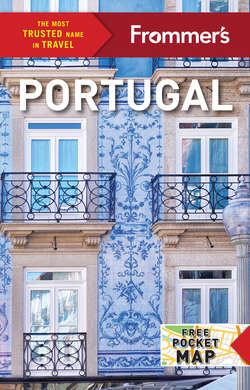Читать книгу Frommer's Portugal - Paul Ames - Страница 5
На сайте Литреса книга снята с продажи.
ОглавлениеA Look at portugal
Portugal is a mystery to most would-be travelers. It's far harder to pin down its public persona than other Western nations. Say the word “Italy” and a slew of images—pasta, hand gestures, suave clothing, and more—pop to mind. The same with “France,” “Germany,” or the “United States.” But to understand Portugal, one must travel there. And listen to the nation’s plaintive fado music, gorge on grilled sardines, and wander over rocky cliffs, through cutting-edge contemporary museums, winding cobblestoned alleys, and churches glittering with colonial-era gold. This book tells you how to do all of that and much more. In the following pages are just a few of the spectacular sights you’ll see.
Go . . . and be dazzled.
– Pauline Frommer
The colorful, eclectic architecture of the Palácio Nacional da Pena, the most recognizable building in Sintra (p. 162).
LISBON
Lisbon is set on seven hills, meaning there’s a gobsmacking view around most every corner. Pictured is the atmospheric Alfama district, which has some of the oldest buildings in the city (built on stronger stone, it wasn’t as badly damaged as other neighborhoods during the 1755 earthquake).
A foodie mecca, Lisbon has a number of outdoor cafes, though few climb the hills as adeptly as this one does.
The Tram 28 line (p. 105), the most famous of Lisbon's iconic yellow trams, runs through Alfama, Baixa, Chiado, and other historic districts.
Climb the Arco da Rua Augusta triumphal arch for 360-degree views over the Baixa district (see p. 122).
Inaugurated in 1902, the imposing Elevador de Santa Justa towers over the Baixa and carries pedestrians up the Largo do Carmo in the Chiado.
Portugal’s most distinctive music is fado, the urban blues of Lisbon, which comes close to encapsulating the nation’s soul.
A UNESCO World Heritage Site, 16th-century Jerónimos Monastery is the city’s most impressive building (p. 108).
The 1880s Mercado da Ribeira/Time Out Market (p. 105) is a historic produce, meat, and seafood market with a gourmet food hall.
The MAAT (Museum of Art, Architecture and Technology), which opened in late 2016, has transformed the cityscape with its sail-like roof jutting out over the river (p. 107).
The village of Óbidos (p. 193) is so pretty King Afonso II gave it as a wedding gift to his queen. It’s a short day-trip from Lisbon.
Sintra Palace (p. 164) rests on a rocky outcrop surrounded by stunning gardens and can be seen for miles around.
A short distance from downtown Cascais, the Boca do Inferno, or Mouth of Hell (p. 150) is a natural rock cavern carved by the waves.
NORTHERN PORTUGAL
Known as the “River of Gold,” the Douro wends its way from north-central Spain to Porto. In Portugal, its often-steep banks are terraced with the vineyards that produce the area’s famous fortified wine.
Espigueiros, raised stone tomblike structures that are actually grain stores, are found near Parque Nacional da Peneda-Gerês (p. 396).
Opened in 1906, Livraria Lello in Porto is regarded as one of the world's most beautiful bookstores (p. 341).
Northern Portugal
With a permanent collection of more than 4,000 works by Portuguese and international artists, Serralves (p. 343) is one of Portugal's most important art museums.
A view of the colorful Ribeira neighborhood (p. 336). It has clung to this hillside since the Middle Ages.
The grand chambers of Porto's Palácio da Bolsa (p. 340), the former Stock Exchange, borrow decorative elements from ancient Rome, Renaissance Italy, and the court of Versailles.
The city’s largely Romanesque Sé (Cathedral, p. 340) was begun in the 12th century.
Pop by for a cimbalino (shot of espresso) at the 1920s-era Café Majestic (see p. 342).
The Arco da Porta Nova (p. 391), a baroque triumphal arch, makes up part of the city walls of Braga.
You can’t say you’ve been to Porto until you’ve tippled your way through a port tasting (see p. 339).
Guimarães’ castle (p. 382), site of an important siege, is considered the birthplace of the nation.
Guimarães’ Largo de Oliveira (Olive Tree Square, p. 383) is rich in history…and taverns. It’s the place to be in the evenings.
A UNESCO World Heritage Site, the hilltop pilgrimage site of Santuário Bom Jesús do Monte is Braga’s best-known landmark (p. 391).
SOUTHERN PORTUGAL
Near Lagos (p. 249), the coast is a wonderland of hidden lagoons, jutting rocks, and grottoes.
A falconer participates in a medieval festival in Silves.
Southern Portugal
From the heady heights of Marvão Castle (p. 290) visitors feel like they can see all of Portugal, and a good swatch of Spain, too.
Grilled sardines are a staple of Portuguese cuisine, their aroma wafting through old towns and along seaside promenades.
A pretty square in Lagos (p. 249). Today known for its beaches and relaxed vibe, its history is darker—as the place where the Atlantic slave trade began in the 1400s.
Stairs lead down to Praia do Camilo (p. 252), one in a series of stunning beaches south of Lagos.
The Algar de Benagil sea cave (p. 235), a natural sandstone formation near Portimão, can be explored via a boat tour or stand-up paddleboard.
Established in 1290, University of Coimbra (p. 299) is one of the oldest universities in the world. It dominates the Alta, or upper town of Coimbra.
Dramatically sited Praia de Carvoeiro beach is the focal point of Carvoeiro (p. 235), a resort town of the Algarve.
Throughout Portugal, you’ll see important works from the many civilizations that once ruled this land. Pictured is a still-standing Roman-era bridge in Tavira.
The Castelo dos Mouros (p. 241) in Silves was the center of the Moorish empire until the Reconquista. All that’s left are ruins.
Sagres (p. 255) was once considered the edge of the world. Hike to the lighthouse for a view of the vast Atlantic, and you’ll understand why.
